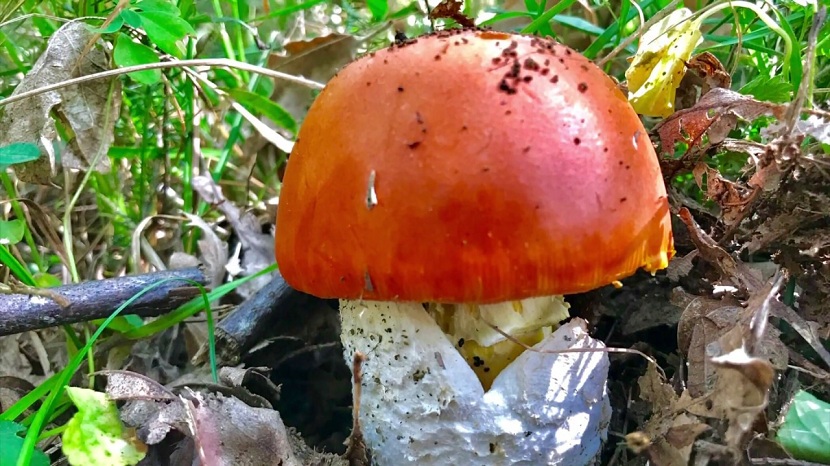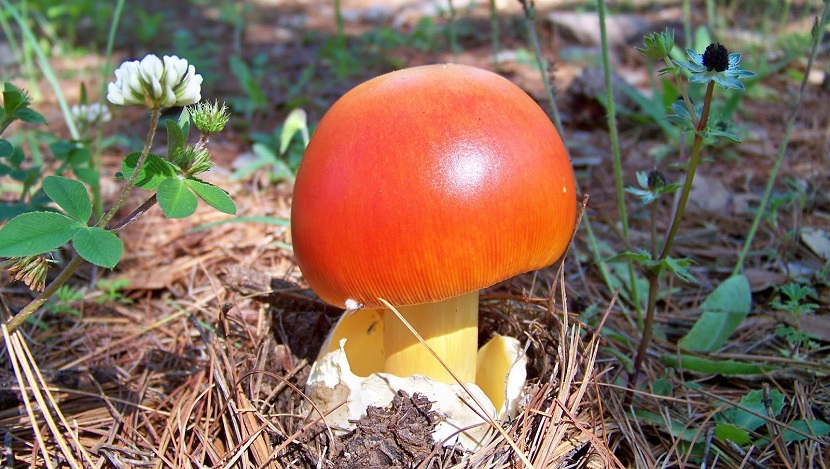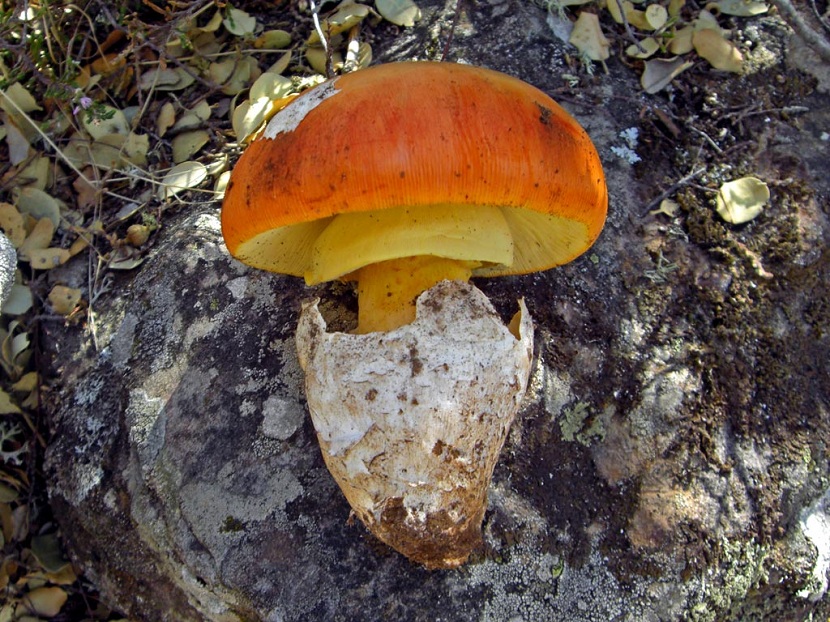
Today we are going to talk about a type of thermophilic mushroom that usually grows when temperatures are higher. It's about the amanita caesarea. It is known by the common name of oronja and caesarea. Some say it is overrated as it tastes good and is often used in the culinary world.
In this article we are going to deepen the amanita caesarea and reveal all its secrets.
Key features

The mushroom sitting hat is quite large. It usually has a diameter that varies between 8 and 25 centimeters. It has an orange cuticle and is fairly easy to recognize. One of the main characteristics that can be seen with the naked eye is that his hat is decorated with large white plates and remains of the volva. To the touch it is fleshy, compact and consistent. A way of recognizing by touching a copy of amanita caesarea and knowing if it is developed or not is that it becomes somewhat spongy with age.
This hat tends to evolve from a more globose to a conversational shape, and finally it is almost flat when it reaches its adult stage. The cuticle can be easily separated revealing the flesh with a yellowish color. This hat has a smooth and somewhat viscous surface when the environment has high humidity. It can also be recognized because it has a bright appearance and especially when it is younger.
The blades are pale yellow in color and, as it develops, they turn to a more yellowish gold. They are quite broad, numerous blades with a flock edge. Inside the blades it has abundant interspersed lamellae called lamélulas. As for the foot, it has a cylindrical shape and is more delegated at the apex, robust and straight. It has a yellowish color like that of the plates and the ring. The foot will be full inside and, as it develops, it modifies its appearance, becoming almost hollow. It is usually between 8 and 20 centimeters in height and 1 and 3 centimeters in diameter.
This foot usually has a fleshy texture and when it is adult it is also spongy. It has a rather fragile ring that has the same yellow color as the foot. When we cut it the color varies from yellow to white. When the specimen is young, the volva that it possesses contains the mushroom as a whole with an egg shape and it develops later in the foot and the hat.
Passing through its meat, we can see that it is white and more yellowish under the cuticle. It has a thick and tender texture. Its flavor is quite pleasant and is usually reminiscent of walnuts. Its smell is mild, although it becomes somewhat more unpleasant in specimens that are already adults.
Ecology and area of distribution of the amanita caesarea

This type of mushroom, so coveted for its flavor, usually sprouts in isolation in some deciduous forests where species such as holm oaks, cork oaks, chestnut trees and oaks mainly frequent. As we mentioned at the beginning of the article, it is a thermophilic species. That is, it usually develops when temperatures are higher and for them are favorable.
It is a species that appears in early autumn or even in the middle of summer. One of the critical conditions for them to begin to develop is that there have been some heavy and repeated storms during the spring and summer. As they need a lot of heat for their growth, as autumn progresses it disappears in areas with less temperate climates.
Regarding its edibility, it is considered an excellent edible. Traditionally it has been considered one of the ruins of edible mushrooms. Some think that they are overrated and that there are other types of mushrooms that are richer and more valuable for the culinary world. However, it is still an exquisite mushroom that can be consumed in numerous and varied ways.
Confusions of the amanita caesarea

It is necessary to take some precautions since this mushroom can be confused with a specimen that belongs to the same genus. It's about the Amanita muscaria. Admittedly, the differences between these two species are quite obvious. With just a simple and quick examination you could clearly determine what is the amanita caesarea. The Amanita muscaria it has a rough volva and is not membranous. Both its foot, the ring and the plates are white and not yellow as in this case. The cuticle is red in color and with numerous small, warty, white spots. In this case, la amanita caesarea has an orange, smooth and striated cuticle.
It can also be confused with other varieties such as Amanita muscaria var. Halo Kalchbr. This specimen in quite specific situations such as discoloration due to excessive sun and rain may have a certain resemblance to the Amanita caesarea. However, The color of the foot and the plates must be decisive, as well as the shape of the volva.
Quality and sale

Given that it is a highly demanded species, it is estimated that only in Europe it has great success and consumption. Basically this consumption occurs in Italy and Switzerland reaching prices of 100 euros per kilo. In Spain, you can pay at the foot of the mountain about 15 euros per kilo. This price varies according to the quality and the state of formation that the mushroom has had. Those mushrooms that are sold in their first stage of growth are usually worth so expensive. In addition, they can be easily recognized as they are egg-shaped.
They are usually more appreciated more than for their gastronomic quality, because they have more time to be able to preserve it before consuming it. In the mushroom harvesting regulations it is forbidden to collect immature mushrooms. Therefore, if someone fear copies of amanita caesarea in a young state, you can know that it is not legal.
As you can see, this mushroom is in high demand and there are people who pay quite high prices for it. I hope that with this information you can learn more about the Amanita caesarea.